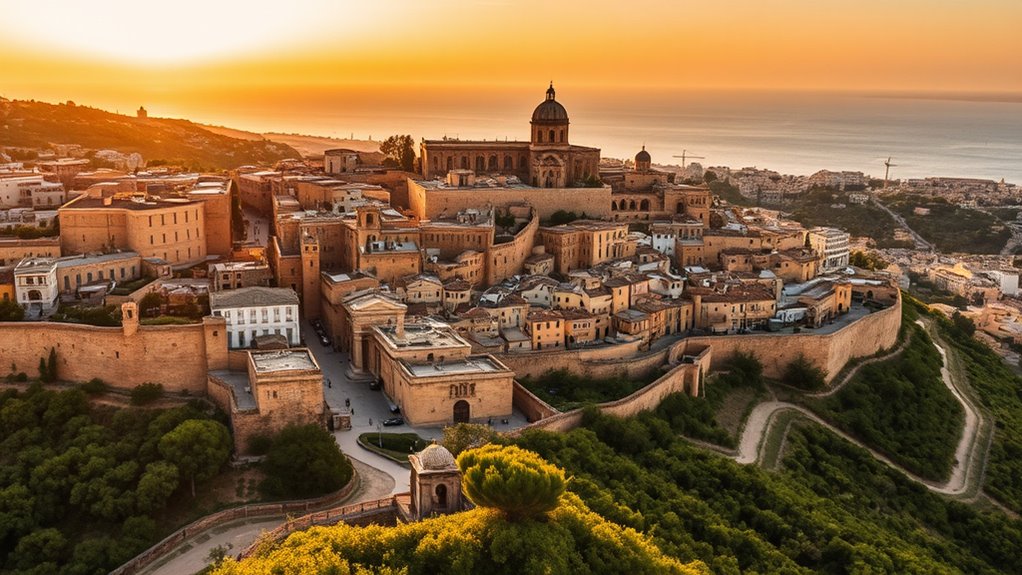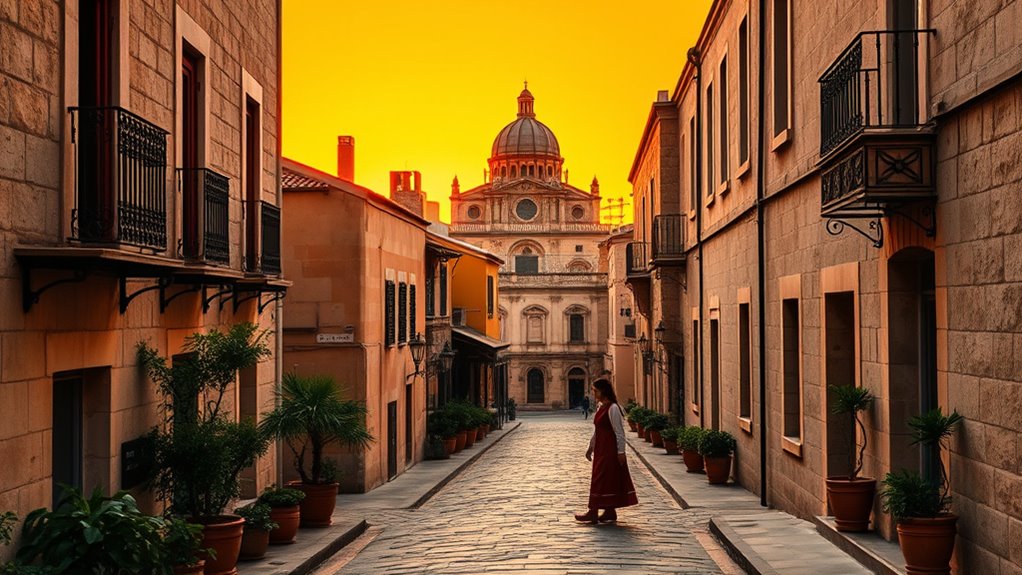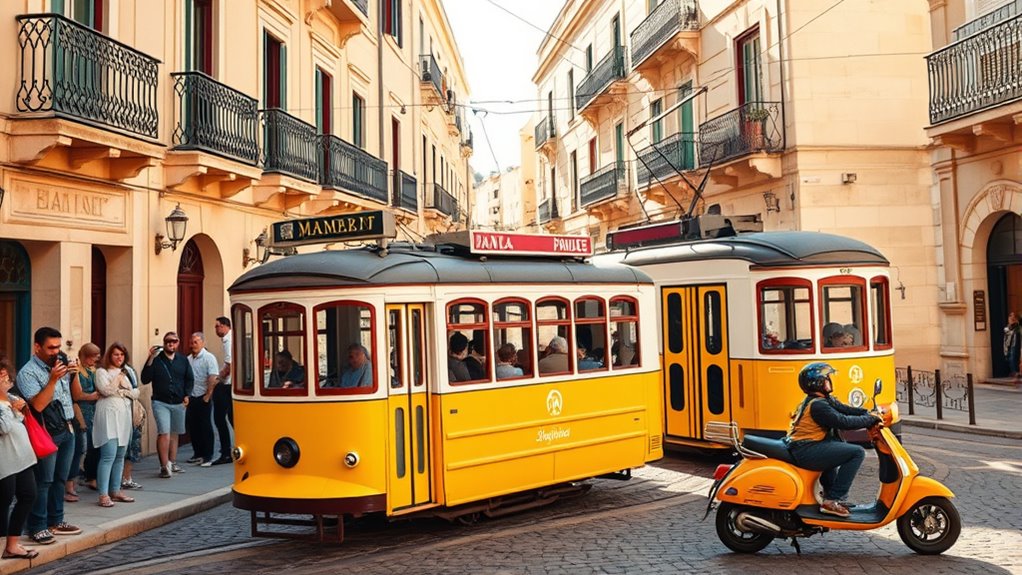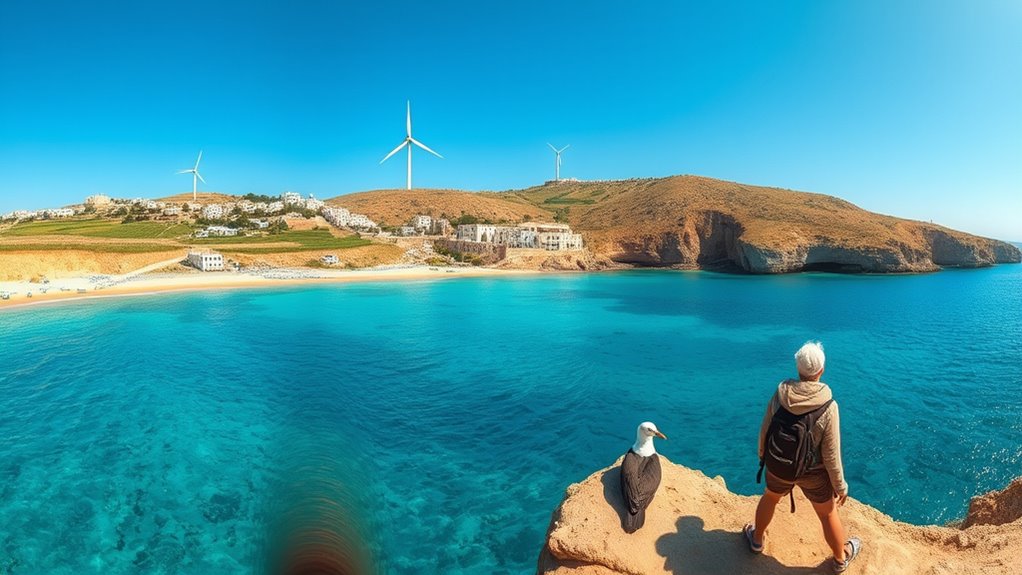Discover the ultimate travel experience in Malta, where ancient UNESCO sites like the Megalithic Temples and Mdina blend with stunning coastlines and clear waters perfect for diving, snorkeling, and water sports. Enjoy exploring historic cities, relaxing on beautiful beaches, and staying in eco-friendly accommodations. Malta’s efficient transport makes getting around easy, and sustainable practices help protect its beauty. Explore this vibrant island’s unique culture and attractions further — there’s more to uncover beyond the surface.
Key Takeaways
- Explore Malta’s UNESCO sites like the Megalithic Temples, Mdina, and the Hypogeum to discover its rich ancient history.
- Enjoy Malta’s stunning beaches, diving spots, and water-based activities like snorkeling, boat tours, and marine exploration.
- Choose eco-friendly accommodations and utilize Malta’s reliable transportation for sustainable and scenic travel.
- Visit cultural festivals, local crafts, and historic towns like Valletta and Mdina for an authentic Maltese experience.
- Support local artisans and practice responsible tourism to preserve Malta’s natural beauty and cultural heritage.
Discovering Malta’s UNESCO World Heritage Sites

Malta’s UNESCO World Heritage Sites offer a mesmerizing glimpse into its rich history and ancient culture. As you explore, you’ll discover remarkable sites like the Megalithic Temples of Ħaġar Qim and Mnajdra, some of the world’s oldest free-standing structures, dating back over 5,000 years. The medieval walled city of Mdina invites you to walk its silent streets, where history whispers from every stone. Valletta, the fortified capital, boasts impressive baroque architecture and historic fortifications that tell stories of its strategic past. Visiting these sites, you’ll experience firsthand Malta’s deep roots in prehistoric, Roman, and medieval history. Each location offers an immersive journey into the island’s storied past, making Malta a true treasure trove for history enthusiasts. Exploring these ancient sites will deepen your appreciation for Malta’s enduring historical legacy.
Top Attractions and Natural Wonders

Malta’s top attractions include UNESCO World Heritage Sites that showcase its rich history and culture. You’ll also encounter stunning coastal landscapes that highlight the island’s natural beauty. These wonders make Malta a must-visit destination for both history lovers and nature enthusiasts. For those interested in exploring local flavors, Malta offers vetted coffee options that enhance the travel experience.
UNESCO Heritage Sites
Are you enthusiastic to explore some of Europe’s most remarkable cultural and natural treasures? Malta’s UNESCO Heritage Sites offer an unforgettable journey into history and architecture. You’ll marvel at the ancient city of Mdina, known as the “Silent City,” with its medieval walls and narrow streets. The UNESCO-listed Ħal Saflieni Hypogeum takes you underground into a prehistoric underground temple complex. You can also visit the Megalithic Temples of Malta, dating back over 5,000 years, making them some of the oldest free-standing structures in the world. These sites reveal Malta’s rich prehistoric past and cultural significance. Exploring these heritage sites, you’ll gain a deeper appreciation for Malta’s historical importance, all while enjoying the preserved beauty and craftsmanship of these ancient treasures. Strong communication skills enhance your understanding of the historical narratives conveyed through these remarkable monuments.
Stunning Coastal Landscapes
From the rugged cliffs to crystal-clear waters, Malta’s stunning coastal landscapes captivate you with their natural beauty. You’ll be drawn to the iconic Blue Lagoon, where turquoise waters meet white sandy beaches—perfect for swimming and snorkeling. The sheer limestone cliffs of Dingli and the dramatic Azure Window ruins (now replaced by the sea but still breathtaking) offer spectacular views and photo opportunities. The unspoiled beaches of Mellieħa Bay and Golden Bay invite you to relax and soak up the Mediterranean sun. For adventure, explore the hidden caves along the coast or plunge into the clear waters to discover vibrant marine life. Malta’s coastal scenery combines rugged charm with serenity, making it an unforgettable part of your travel experience. Additionally, exploring solar panels for camping can be an eco-friendly way to power your outdoor adventures and enhance your appreciation of nature’s beauty.
Cultural Experiences and Historical Tours

Exploring Malta’s rich cultural heritage offers an immersive journey into one of Europe’s most historic destinations. You’ll discover ancient temples like Ħaġar Qim and Mnajdra, dating back over 5,000 years. The capital, Valletta, boasts magnificent Baroque architecture and UNESCO World Heritage sites, including the Grandmaster’s Palace. Guided tours highlight Malta’s strategic role in Mediterranean history, from the Knights of St. John to World War II. Don’t miss exploring Mdina, the silent city, with its medieval walls and narrow alleys. These sites reveal Malta’s layered past and vibrant traditions. To help you plan, here’s a quick overview of key experiences:
| Cultural Site | Highlights |
|---|---|
| Valletta | Baroque architecture, museums |
| Ħaġar Qim & Mnajdra | Ancient temples, archaeological sites |
| Mdina | Medieval city, silent streets |
| The Knights’ Palaces | Historic governance, art collections |
| Malta National Museum | Art, history, and cultural exhibits |
Malta’s cultural heritage is also enriched by traditional festivals and local crafts that provide a deeper understanding of its vibrant community.
Best Beaches, Diving, and Water Activities

After immersing yourself in Malta’s rich cultural and historical sites, you’ll find that its stunning beaches and vibrant water activities offer the perfect complement to a well-rounded visit. Malta’s clear, azure waters are ideal for snorkeling and swimming, with popular spots like Golden Bay and Mellieħa Bay offering calm, shallow waters. For diving enthusiasts, Malta is Europe’s top destination, boasting world-renowned sites such as the Blue Hole and the Santa Maria Caves. You can explore vibrant coral reefs, underwater caves, and wrecks like the P29 patrol boat. Water sports are everywhere, from jet skiing and windsurfing to kayaking and boat tours. Whether you’re relaxing on a secluded beach or diving into the Mediterranean’s depths, Malta’s water activities guarantee an exhilarating, memorable experience. Diving is a major attraction, with numerous dive centers providing equipment rentals and guided tours for all skill levels.
Where to Stay: Accommodation Options and Trends

Malta’s accommodation scene is thriving, with high occupancy rates in hotels reflecting increased visitor numbers. You’ll find a growing demand for eco-friendly and unique stays, catering to travelers seeking authentic experiences. As the island continues to attract more visitors, staying in innovative or sustainable lodgings can enhance your trip. Additionally, considering effective fraud prevention tools when booking online can help safeguard your reservations.
Hotel Occupancy Trends
Hotel occupancy in Malta has been on the rise, reflecting strong demand across various accommodation types. In Q2 2025, 4-star hotels reached 92% occupancy, a 2.2% increase from the previous year, showing their popularity among travelers. Meanwhile, 5-star hotels posted 78.4% occupancy, up 2.5%, indicating continued luxury appeal. Slightly lower but still high, 3-star hotels experienced a small dip to 90.6%, down 0.4%. The overall trend highlights a thriving hospitality sector driven by record visitor numbers and increased spending. High occupancy rates are especially evident during peak months, with popular areas experiencing intense demand. Malta’s compact size and diverse options keep occupancy rates elevated year-round, supporting the island’s reputation as a premier Mediterranean destination. Additionally, effective hotel management practices contribute to maintaining high occupancy levels and guest satisfaction.
Eco-Friendly and Unique Stays
As the demand for authentic and sustainable travel grows, Malta’s accommodation options are increasingly featuring eco-friendly and unique stays that cater to eco-conscious visitors. You’ll find eco-resorts and green-certified hotels that prioritize renewable energy, waste reduction, and water conservation, all while offering stylish comfort. For a truly distinctive experience, consider staying in restored farmhouses, converted windmills, or boutique guesthouses nestled in scenic locations. Many of these properties emphasize local craftsmanship and eco-friendly practices, giving you a more authentic connection to Malta’s culture and environment. Incorporating Steampunk and Victoriana elements into some boutique accommodations adds a touch of vintage-industrial charm, making your stay even more memorable. Booking these stays supports sustainable tourism efforts and helps preserve Malta’s natural beauty. Whether you seek luxury eco-lodges or charming eco-bungalows, Malta’s innovative accommodations ensure your stay is memorable and environmentally responsible.
Getting Around: Transportation and Accessibility

Getting around Malta is straightforward thanks to its well-developed transportation network. You can easily navigate the island using buses, which are reliable, affordable, and cover major tourist spots and towns. The Malta Public Transport system operates frequently, making it simple to plan your day without a car. Taxis and ride-sharing services like Bolt are available for more convenience or late-night travel. If you prefer flexibility, renting a car or scooter allows you to explore hidden corners at your own pace. Walking is also enjoyable in compact towns like Mdina or Valletta. For island hopping, ferries connect Malta with nearby islands like Gozo and Comino, providing scenic and efficient transfers. Overall, Malta’s transportation options make getting around quick, accessible, and stress-free. Incorporating networking and staying updated on industry trends can also help travelers discover new transportation options and tips.
Sustainable Tourism and Responsible Travel Tips

Exploring Malta’s rich history and vibrant culture is best done with a mindful approach that respects the island’s natural and cultural treasures. To practice responsible travel, consider these tips:
Discover Malta responsibly by respecting nature, supporting sustainable businesses, and engaging authentically with local culture.
- Respect natural sites by sticking to designated paths and avoiding littering, helping preserve Malta’s stunning landscapes.
- Support eco-friendly accommodations and local businesses that prioritize sustainability, reducing your ecological footprint.
- Engage authentically by participating in cultural tours and trying local cuisine, fostering meaningful connections and cultural appreciation.
Frequently Asked Questions
What Are the Best Times to Visit Malta to Avoid Crowds?
You should visit Malta in the shoulder seasons of spring (April to early June) or fall (September to October). During these months, you’ll find fewer crowds at popular sites like the Blue Lagoon and UNESCO sites. The weather is still pleasant, and accommodation prices are lower. Avoid peak summer months, especially July and August, when tourism surges and attractions get crowded, making your experience less relaxed.
How Can I Experience Malta’s Local Culinary Scene Authentically?
Ever wondered how to truly savor Malta’s rich culinary roots? Immerse yourself in local markets like Marsaxlokk and try traditional dishes such as rabbit stew or ftira. Visit family-run taverns for authentic flavors and engage with locals to learn about culinary customs. Attend food festivals or take cooking classes to deepen your experience. By immersing yourself in everyday food scenes, you’ll discover Malta’s cuisine beyond the tourist spots.
Are There Any Hidden Gems or Off-The-Beaten-Path Sites in Malta?
Yes, you can find hidden gems in Malta by exploring the lesser-known villages like Gharb and Żebbuġ, where authentic rural charm thrives. Visit secluded beaches like Għajn Tuffieħa or walk through ancient, less crowded sites such as the Ta’ Ħaġrat Temples. These spots offer genuine cultural experiences away from tourist crowds, allowing you to enjoy Malta’s rich history, natural beauty, and local life more intimately.
What Safety Tips Should Tourists Follow When Exploring Natural Attractions?
When exploring Malta’s natural attractions, always stay on designated paths to protect the environment and avoid accidents. Wear sturdy shoes and bring plenty of water, especially in hot weather. Keep an eye on weather conditions, as sudden storms can be dangerous near cliffs or coastal areas. Follow safety signs, don’t venture into restricted zones, and respect local wildlife. If in doubt, ask a local or guide for advice.
How Accessible Are Malta’s Historical Sites for Travelers With Mobility Issues?
You’ll find Malta’s historical sites surprisingly welcoming, even if your mobility is less than legendary. Many attractions now offer ramps, accessible pathways, and tailored tours, making it easier to explore ancient temples and forts. Still, some sites, like underground catacombs or rugged ruins, might require extra effort or assistance. So, plan ahead, ask about accessibility options, and you’ll enjoy Malta’s rich history without feeling like you’ve been left behind.
Conclusion
Malta is a treasure chest waiting to be opened. Just like exploring a hidden cave reveals sparkling secrets, your journey through its UNESCO sites, stunning beaches, and rich history will uncover unforgettable memories. With over 2 million visitors annually, Malta proves that small island magic leaves a big impact. So, pack your curiosity and plunge in—every corner of Malta has a story to tell, ready to become your next adventure’s shining gem.






